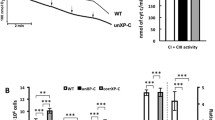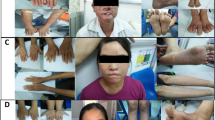Summary
Chediak-Higashi syndrome (CHS) cells have been previously observed to exhibit several of the same characteristics as those of xeroderma pigmentosum (XP) and xeroderma pigmentosum variants. Cultured CHS fibroblasts have been examined for altered responses in both depletion of NAD and elevation of diadenosine-5′,5‴-tetraphosphate (Ap4A) following DNA damage since both responses have been reported as altered in XP cells and since Ap4A has been reported as absent from the platelets of CHS patients. Lowering of NAD following UV irradiation occurred in CHS cells in a manner similar to that of control and XP variant cells, but different from that of XP cells. CHS fibroblasts were not found to be deficient in Ap4A and exhibit basal levels very similar to those of control fibroblasts. No change in Ap4A pools were observed which correlated with cell growth, in contrast to previously published reports. Furthermore, while Ap4A levels are not elevated in XP cells, we observe an elevation of Ap4A pools in CHS cells which mimics the elevations observed in control and XP variant cells. We conclude that:
-
(1)
CHS cells more closely resemble control or XP variant cells than XP cells with regard to NAD lowering and Ap4A elevation following UV irradiation;
-
(2)
the photosensitivity exhibited by CHS cells is not due to general defects in the synthesis of poly(ADP-ribose) from NAD or in Ap4A metabolism; and
-
(3)
alteration of Ap4A pool size in CHS fibroblasts is inappropriate as a biochemical marker for CHS.
Similar content being viewed by others
References
Arlett, C. F. Human DNA repair defects.J. Inher. Metab. Dis. 9 (suppl. 1) (1986) 69–84
Baker, J. C. and Jacobson, M. K. Determination of diadenosine-5′,5‴-P1,P4-tetraphosphate levels in cultured mammalian cells.Anal. Biochem. 141 (1984) 451–460
Baker, J. C. and Jacobson, M. K. Alterations of adenyl dinucleotide metabolism by environmental stress.Proc. Natl. Acad. Sci. USA 83 (1986) 2350–2352
Baker, J. C. and Ames, B. N. Alterations in levels of diadenosine-5′,5‴-P1,P4-tetraphosphate (Ap4A) following DNA damage in normal human fibroblasts and fibroblasts derived from patients with xeroderma pigmentosum.Mutat. Res. (in press)
Berger, N. A., Sikorski, G. W., Petzold, S. J. and Kurohara, K. K. Defective poly(adenosine diphosphoribose) synthesis in xeroderma pigmentosum.Biochemistry 19 (1980) 289–293
Blume, R. S. and Wolff, S. M. The Chediak-Higashi syndrome: studies in four patients and a review of the literature.Medicine 51 (1972) 247–280
Dunn, W. C. and Regan, J. D. Inhibition of DNA excision repair in human cells by arabinofuranosyl cytosine: effect on normal and xeroderma pigmentosum cells.Mol. Pharmacol. 15 (1979) 367–374
Flodgaard, H. and Klenow, H. Abundant amounts of diadenosine-5′,5‴-P1,P4-tetraphosphate are present and releasable, but metabolically inactive, in human platelets.Biochem. J. 208 (1982) 737–742
Garrison, P. N., Mathis, S. A. and Barnes, L. D.In vivo levels of diadenosine tetraphosphate and adenosine tetraphospho-guanosine inPhysarum polycephalum during the cell cycle and oxidative stress.Mol. Cell. Biol. 6 (1986) 1179–1186
Hannan, M. A., Sabbath, R. S. and Gibson, P. Study of DNA repair deficiency in a patient with Chediak-Higashi syndrome by analysis ofin vitro radiosensitivity of peripheral lymphocytes.IRCS Med. Sci. 13 (1985) 807–808
Hiss, E. A. and Preston, R. J. The effects of cytosine arabinoside on the frequency of single strand breaks in DNA of mammalian cells following irradiation or chemical treatment.Biochim. Biophys. Acta 478 (1977) 1–8
Jacobson, E. L. and Jacobson, M. K. Pyridine nucleotide levels as a function of growth in normal and transformed 3T3 cells.Arch. Biochem. Biophys. 175 (1976) 627–634
Kim, B. K., Chao, F. C., Leavitt, R., Fauci, A. S., Meyers, K. M. and Zamecnik, P. C. Diadenosine-5′,5‴-P1,P4-tetraphosphate deficiency in blood platelets of the Chediak-Higashi syndrome.Blood 66 (1985) 735–737
Luthje, J. and Ogilvie, A. The presence of diadenosine-5′,5‴-P1,P3-triphosphate (Ap3A) in human platelets.Biochem. Biophys. Res. Commun. 115 (1983) 253–260
Luthje, J., Baringer, J. and Ogilvie, A. Highly efficient induction of human platelet aggregation in heparinized platelet-rich plasma by diadenosine triphosphate (Ap3A).Thromb. Haemostasis 54 (1985) 469–471
McCurry, L. S. and Jacobson, M. K. Poly(ADP-ribose) synthesis following DNA damage in cells heterozygous or homozygous for the xeroderma pigmentosum genotype.J. Biol. Chem. 256 (1981) 551–553
Rapaport, E. and Zamecnik, P. C. Presence of diadenosine-5′,5‴-P1,P4-tetraphosphate (Ap4A) in mammalian cells in levels varying widely with proliferative activity of the tissue: a possible positive “pleiotropic activator”.Proc. Natl. Acad. Sci. USA 73 (1976) 3984–3988
Tanaka, H. and Orii, T. High sensitivity but normal DNA repair activity after UV irradiation of Epstein-Barr virus-transformed lymphoblastoid cell lines from Chediak-Higashi syndrome.Mutat. Res. 72 (1980) 143–150
Tanaka, H., Ito, T., and Orii, T. DNA repair mechanisms in Chediak-Higashi syndrome cells.J. Inher. Metab. Dis. 5 (1982) 65–66
Weinman-Dorsch, C., Hedl, A., Grummt, I., Albert, W., Ferdinand, F., Friis, R., Pierron, G., Moll, W. and Grummt, F. Drastic rise of cellular adenosine (5′)tetraphospho(5′) adenosine correlates with onset of DNA synthesis in eukaryotic cells.Eur. J. Biochem. 138 (1984) 179–185
Whitkop, C. J., Quevedo, W. C. and Fitzpatrick, T. B. Albinism and other disorders of pigment metabolism. In Stanbury, J. B., Wyngaarden, J. B. Fredrickson, D. S., Goldstein, J. L. and Brown, M. S. (eds)The Metabolic Basis of Inherited Disease (5th edition) McGraw-Hill Book Company, New York, 1983, pp. 301–346
Author information
Authors and Affiliations
Rights and permissions
About this article
Cite this article
Baker, J.C., Ames, B.N. Alterations of NAD and adenylyl dinucleotide metabolism in Chediak-Higashi Syndrome fibroblasts. J Inherit Metab Dis 11, 221–228 (1988). https://doi.org/10.1007/BF01800362
Received:
Accepted:
Issue Date:
DOI: https://doi.org/10.1007/BF01800362




